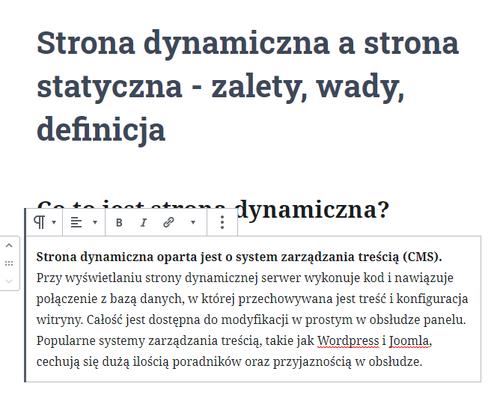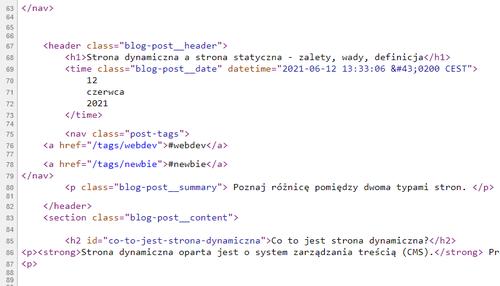Dynamic website vs. static website - pros, cons and definition
Learn the differences between the two types of sites: dynamic and static. A practical list of the most important pros and cons.

What is a dynamic website?
A dynamic site is based on a content management system (CMS). In order to display a dynamic site, the server must execute code and establish a connection to a database that stores the website’s content and configuration. Content is typically managed in an easy-to-use panel. Popular content management systems, such as Wordpress, often have lots of tutorials and learning materials available.
The CMS makes it easy to edit content and add new sub-pages on your own. No programming skills are required to operate it. A dynamic site typically allows you to easily enrich it with interactive elements, such as a contact form or a comment system. Popular CMSes have a large number of free plug-ins available that allow you to extend their functionality.
Disadvantages of a dynamic site
A dynamic site is more complex to implement and configure than a static site. A CMS requires a database and a code interpreter, making the site more expensive to maintain. The estimated annual cost of maintaining a simple dynamic site is about $50, with the specific amount unclear depending on the hosting offer. It is strongly recommended to regularly update the CMS, as using an outdated version may allow hackers to gain access or post spam.
What is a static website?
** A static website does not have a content management system.** It is usually created with pure HTML code, therefore the server only returns the finished result without any processing involved. The content is stored in files, eliminating the need for database access.
A static site means lower maintenance costs - thanks to Netlify or Github Pages hosting can be completely free. In addition we don’t have to worry about CMS updates - the site will always remain secure, as there is no potential attack vector.
Disadvantages of a static site
As a disadvantage, it can be considered difficult to modify the content - at least basic HTML knowledge is required. A static site will not be equipped with most interactive elements, such as comments or contact forms. It cannot be quickly converted into a dynamic site, which typically is a time-consuming process.
Due to the above differences, it is important to make the right choice before starting to create a website.
What type of site to choose?
A static site will work great when:
- we want to update the content once every few months, once a year at most;
- we do not plan to create a blog or add new subpages;
- we want to reduce our costs to a minimum;
- we only want to mark our presence on the Internet.
If we want to regularly update our offer, update the site with new photos, or set up a blog - in such situations we should reach for a dynamic site. The benefits will outweigh the additional cost of implementing and maintaining the site.
You can follow my blog with any

I write mostly about my projects, sports, and programming - see all posts.

RAG, or how to talk to our documents?
Discover how Retrieval Augmented Generation enables large language models (LLMs) to provide accurate answers based on expertise.

Victory at HackYeah 2023!
On 30.09 - 01.10, we took 1st place out of 37 teams in the Health & Well-being track at HackYeah 2023, the largest on-site hackathon in Europe! 🏆

Eastern Poland by bike - adventure on two wheels
Beautiful views, wilderness camps and duct tape. Read about the cycling adventures of a thousand kilometers and eleven days of riding!

